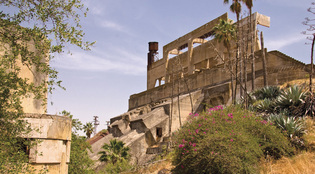 loading
loading
Light & VerityA peace park for the Middle EastSite spans Israeli and Jordanian sides of the Jordan River.  Andrei HarwellA former hydroelectric plant on the Jordan River is the site of a proposed park. Alan Plattus ’76 led a team from Yale that developed a design for the site. View full imageWhen diplomats look for solutions to the seemingly intractable Israeli-Palestinian conflict, "send architects" has never been high on the list. But a group from the Yale School of Architecture spent several days in the Middle East in May working on a project that combines tourism and sustainability, with the ultimate goal of fostering goodwill. Five Yale professors of architecture and environmental studies, along with three architecture students two weeks shy of graduation, participated in a charrette -- an intense architectural design workshop -- on the site of a proposed "peace park" that will span the Israeli and Jordanian sides of the Jordan River. A few days after the charrette, the team presented its initial proposals at two forums, one in Amman, Jordan, the other in Jerusalem. The project is being spearheaded by Friends of the Earth Middle East (FoEME), an environmental organization with Israeli, Jordanian, and Palestinian co-directors. The proposed park is the site of a hydroelectric power plant that supplied electricity on both sides of the river from 1932 until 1948, when it ceased operation due to the Israeli-Arab war. It has been a closed military zone ever since. The plant was built on an island created at the juncture of the Jordan and Yarmouk rivers; the 1,200-acre site today includes the abandoned plant, associated canals and bridges, and cabins that housed the plant's workers. One of the goals of the Yale participants was to re-imagine uses for these elements in a park that will promote "regulated tourism, sustainable development, and goodwill between neighboring countries," according to a statement from FoEME. Another goal is to allow biodiversity to flourish once all forms of physical boundaries are removed (although boundaries will still be maintained around the periphery of the park). The effort stems from FoEME's campaign to restore the Jordan River, which, on its lower stretch from the Sea of Galilee to the Dead Sea, has been reduced to only five percent of its historic flow and resembles a sewage channel more than one of the world's most sacred rivers. The site will include four ecosystems: river, wetland, arid landscape, and arid agriculture. Its promoters say it offers an extraordinary opportunity to incorporate two of the fastest-growing elements of tourism: ecotourism and heritage tourism. "The overall goal is to make that shared cultural and environmental heritage accessible and understandable to a broad range of people with very diverse backgrounds and very diverse interests," says Alan Plattus ’76, professor of architecture and urbanism at the School of Architecture. "People will not come to this site out of the same motivation. But our aim is to create a vivid and open place where those visitors can meet, at least for the time they're on the site, in peace and understanding, to appreciate the past, to take some degree of shared pleasure in the present and its evolution towards a future for the river and for the region that we hope will be a positive future." But as if to underscore the political difficulties involved in such a cross-border project, both the Palestinian and Jordanian co-directors of FoEME arrived at the forum late. One was delayed at a checkpoint on the West Bank, and the other was delayed crossing the Allenby Bridge from Jordan. In addition, one of the local Jordanian mayors involved in the project didn't make it at all because he couldn't get a visa to enter Israel.
The comment period has expired.
|
|